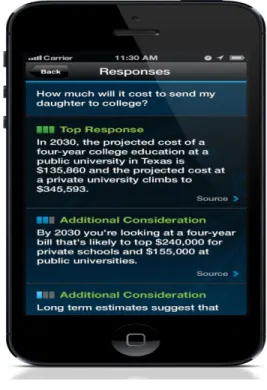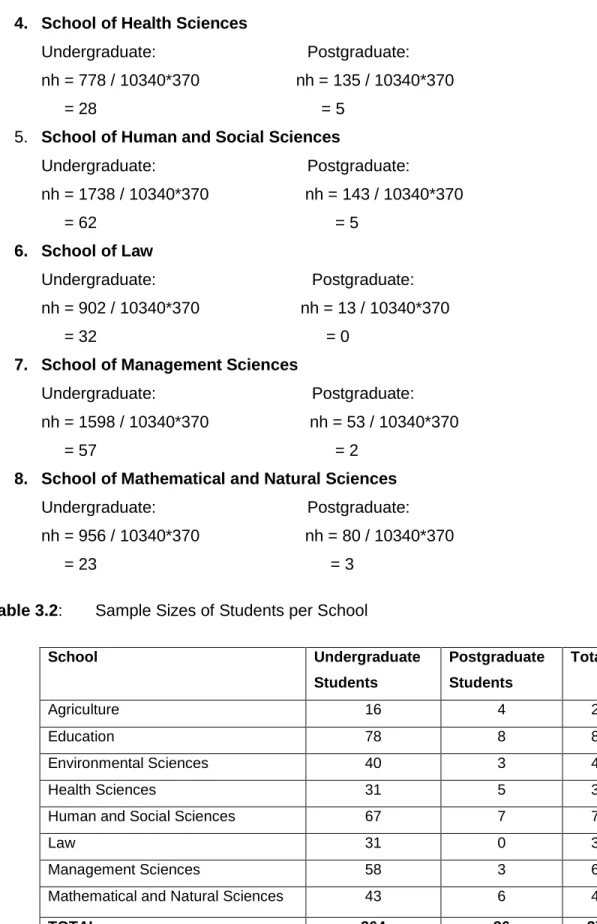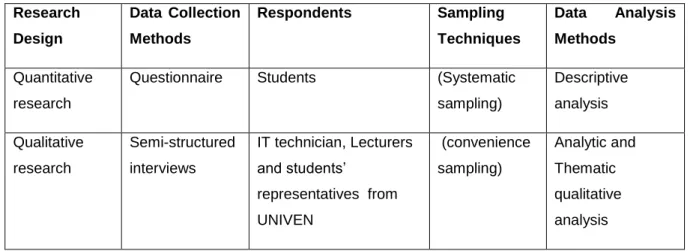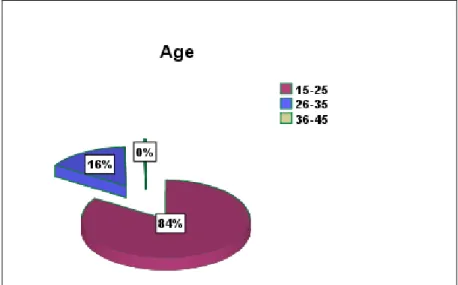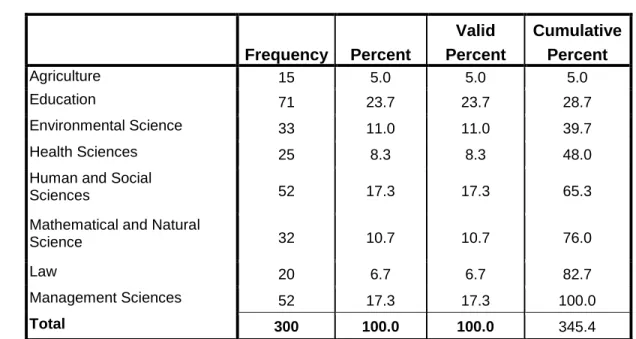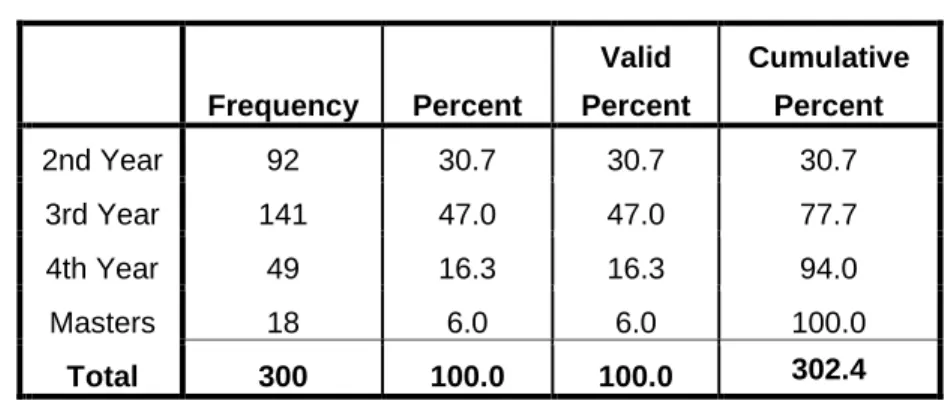The purpose of the study was to investigate the use of digital mobile devices (tablets and smartphones) to enhance teaching and learning at the University of Venda. Recommendations were made on how students and teachers can effectively use digital mobile devices for teaching and learning.
INTRODUCTION
BACKGROUND TO THE STUDY
I MPACT OF M OBILE D EVICES
Mobile devices are being embraced by institutions in higher education (Johnson, Becker, Cummins, Estrada, Freeman, & Ludgate, 2013). Significant investments in arranging content, infrastructure and resources related to the integration of mobile devices in learning environments have been made by institutions (Johnson et al., 2013).
I NFUSION OF M OBILE D EVICES IN R URAL U NIVERSITIES
In 2015, the university made national history in higher education by distributing tablet PCs to more than 13,000 students with the aim of enhancing the quality of teaching and learning (Nendila, 2015. The study therefore examined the prevailing levels of use of mobile devices technology in teaching and learning at the University of Venda, the factors and obstacles that affect the use of these technologies in teaching and learning and their impact on teaching and learning.
PROBLEM STATEMENT
The problem addressed in this research is that the current status of the use of mobile devices in teaching and learning and the adoption of tablet PCs by students and teachers was educationally unknown as it was a new phenomenon at the University from Venda. Therefore, it was necessary to investigate the pedagogical value and use of mobile technologies in teaching and learning.
AIM AND OBJECTIVES OF THE STUDY
A IM
However, it is not clear whether such efforts have resulted in the appropriate application and integration of these technologies in teaching and learning. The introduction of tablet computers may not be a panacea for improving the quality of teaching and learning, especially for a population unfamiliar with the latest technologies.
O BJECTIVES
There was no evidence of students' perceptions of the adoption of these technological innovations and how they should be used in college. There was also a need to explore the extent to which the introduction of tablet PCs is potentially useful in developing strategies that can help curb sluggish adoption, uncertainties and unfamiliarity and presumably improve the quality of teaching and learning at UNIVEN.
RESEARCH QUESTIONS
SIGNIFICANCY OF THE STUDY
S TUDENTS
L ECTURERS
M ANAGEMENT
DELIMITATIONS OF THE STUDY
OPERATIONAL DEFINITIONS
Mobile learning is the use of portable electronic devices to access and share information (Miller, 2012). Teaching and learning is defined as the impact of knowledge by teachers and the acquisition of knowledge by students through studying or being taught (Wallace, 2014).
OUTLINE OF THE RESEARCH
Data collection strategies, description of research methods, instruments, recording and transcription of data are provided in this chapter. The research methodology defines the modalities of the process and the systematic account of what will be done to evaluate the possible use of mobile devices in the University of Venda.
INTRODUCTION
HISTORY OF MOBILE PHONES
High-end mobile phones ('smartphones') allow users to install very advanced applications based on a specific platform. The first of Nokia's smartphones were the Nokia communicator lines that started as Nokia 9000 and were released in 1996 (Lipscomb et al., 2005).
MOBILE DEVICES
According to Woodcock, Middleton and Nortcliffe (2012), smartphones emerged as hybrids of mobile phones and Personal Digital Assistants in the 1990s. Tablets then exploded onto the market after the release of Apple's first iPad in March 2010 (Johnson, Broen and Becker, 2013).
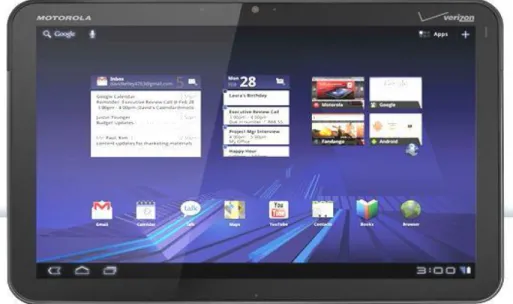
MOBILE LEARNING
According to Mokoena, mobile learning could be considered "learning that occurs when the learner is not stationed, in a predetermined location, or where hand-held devices such as mobile phones, PDAs and palmtops and tablet PCs are dominant technologies". El-Hussein and Cronje (2010) explained that we can only conclude that the technology used for learning can be considered fully mobile when wireless digital device technologies are used and when students use it for self-management in higher education .
EXPERIENCES OF MOBILE DEVICES’ USE
- M OBILE DEVICES ’ USE IN C ANADA
- Challenges in the adoption of Mobile Learning in Canada
- M OBILE DEVICES ’ USE IN THE USA
- Challenges in the adoption of Mobile Learning in the US
- M OBILE DEVICES ’ USE IN E UROPE
- Challenges in the adoption of Mobile Learning in Europe
- M OBILE DEVICES ’ USE IN L ATIN A MERICA
- Challenges in the adoption of Mobile Learning in America
- M OBILE DEVICES ’ USE IN A SIA AND THE P ACIFIC
- Challenges in the adoption of Mobile Learning in Asia and the Pacific
- M OBILE DEVICES ’ USE IN A FRICA
- Challenges in the adoption of Mobile Learning in Africa
- M OBILE DEVICES ’ USE IN S OUTH A FRICA
- M OBILE DEVICES ’ USE AT UNIVEN
- Connectivity Challenges and Security
- Social and educational challenges
- Teaching and Learning theories
- Applications for teaching and learning
- Social networking as a learning platform
- The Blackboard use at UNIVEN
Start-up costs for the mobile learning initiatives when the BYOD approach is not followed. China has become one of the countries with the highest growth rate of mobile learning (over 60%) since 2010 (Adkins, 2011).
SUMMARY
INTRODUCTION
RESEARCH DESIGN
C ASE S TUDY D ESIGN
Mayisela (2013: 6) defined a case study study as “aiming to gain greater knowledge and understanding of the dynamics of a specific situation”. A case study is used as it provides a large amount of description and detail about a particular case which is the University. A case study is a good method to study a rare phenomenon, a large amount of description and detail, a good source of ideas about behavior and a good method to challenge theoretical assumptions (Kharabsheh, 2013).
MIXED METHODS RESEARCH METHODOLOGY
Q UANTITATIVE R ESEARCH M ETHODOLOGY
Quantitative research method aims to quantify the data to generalize the results and measure the sample (Mark et al., 2005). A key advantage of quantitative research is that data can be aggregated and summarized through statistical analysis.
Q UALITATIVE R ESEARCH M ETHODOLOGY
POPULATION AND SAMPLING
- P OPULATION
- S AMPLING A PPROACH
- S AMPLING T ECHNIQUES
- S AMPLE SIZE
- Sampling Process for quantitative method
- S AMPLING P ROCEDURE FOR QUANTITATIVE
- S AMPLING P ROCEDURE FOR QUALITATIVE
According to Wild and Diggins (2013), convenience sampling involves taking a sample from a portion of the population that is readily available or accessible to the researcher. The sample size helps the researcher to ensure a meaningful plan to determine the number he or she wants to draw from the population and also that the sample should be representative of the entire population (Weirs, 2011). Sample size calculation was performed using Raosoft sample size calculator with a 95% confidence level and 5%.
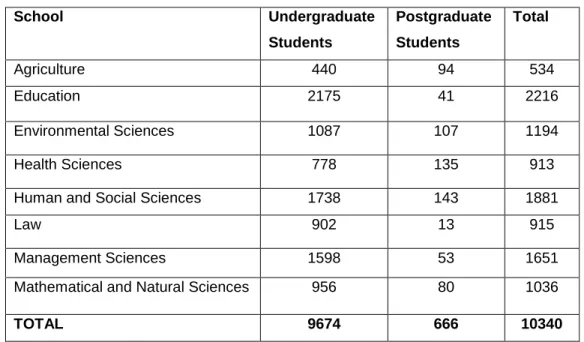
DATA COLLECTION
Q USTIONNAIRES
- Design of the Questionnaire Refer to Appendix
- Pre-testing questionnaire
- Administration of the Questionnaires
The duration of the survey is such that the participants feel motivated to complete the survey and do not lose interest. The researcher used questionnaires to collect data as they help with easy access to potential respondents. The researcher explained the purpose of the study to the participants and asked if they wanted to participate.
S EMI - STRUCTURED I NTERVIEWS
- Pretesting the Interview guide Refer to Appendix
- Administration of the Interview
The researcher distributed the questionnaires to the available students from all schools from the second year level up to the graduate level over a period of two months. E-mails were sent to the school leaders with a request for an interview date and time. The interviews for teachers and the IT technician were conducted with those who were available and willing to participate.
DATA ANALYSIS
Based on the comments received during the pre-test, changes were made to the interview questions to make them clearer before being used in the actual interview. The researcher conducted the interviews with 8 teachers from all schools, 8 representatives from student schools and an IT technician from the University of Venda.
VALIDITY AND RELIABILITY
ETHICAL MEASURES
SUMMARY
DATA INTERPRETATION AND ANALYSIS
INTRODUCTION
REALISATION RATE
DEMOGRAPHIC PRESENTATION
- G ENDER A NALYSIS
- P ARTICIPANTS ’ A GE
- S CHOOL
- L EVEL OF STUDY
Participants were asked to indicate their respective schools and the results are shown in Table 4.1. The highest percentage of 47% is for third year students followed by 30.7% for second year students. These results are in line with the number of students and postgraduates (Honours and Masters).
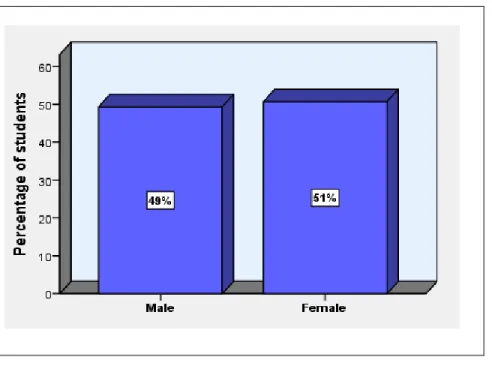
CURRENT MOBILE DEVICES’ USE
- P RIOR K NOWLEDGE OF INTERNET USE
- P RIOR K NOWLEDGE OF MOBILE LEARNING
Since the aim of the study is to determine the current use of mobile devices, which are smartphones and tablet PCs at UNIVEN, the researcher excluded first-year and PhD students. As explained by Martin and Ertzberger (2013), smartphones and tablet PCs have many features relevant to mobile learning. The prior knowledge helped to know how the students have used their smartphones and tablet PCs for learning.
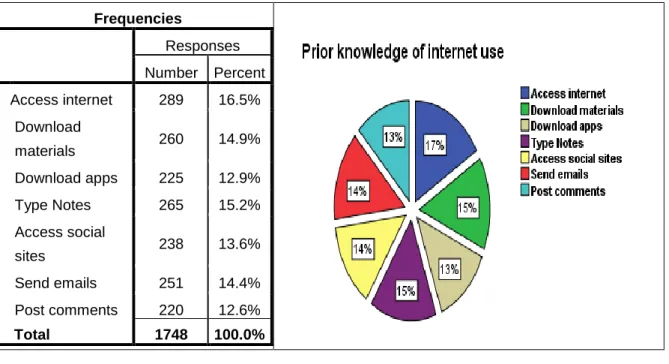
MOBILE LEARNING USEFULNESS
- H OW MOBILE DEVICES AFFECT STUDENTS IN CLASS
- C OMMUNICATION I MPROVEMENT
- L EARNING ANYWHERE WITH MOBILE DEVICES
- T RADITIONAL L EARNING VS MOBILE LEARNING
- T IME SPENT ON DIFFERENT I NTERNET ACTIVITIES
13.5% of students use mobile devices to take videos and photos for assignments or class use. It can be seen that students are able to use their mobile devices both in and out of the classroom. The first pie chart in Figure 4.4 shows that 73% of respondents were enjoying learning using their mobile devices.
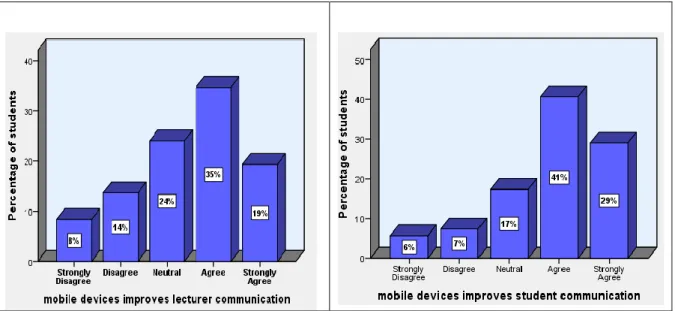
CAPABILITIES ENHANCING STUDENTS’ LEARNING
- P ROMOTING MOBILE LEARNING IN CLASS
- D OWNLOADING A PPLICATIONS USING MOBILE DEVICES
- W AYS OF USING MOBILE DEVICES
- M OBILE D EVICES FOR LEARNING
- T ABLET PC AS A LEARNING TOOL
Results on whether participants would want to download apps to their mobile devices that would help them with their schoolwork are shown in Figure 4.9. This can be seen as a backlash from mobile devices as some students will not pay attention but will instead be on social networks such as WhatsApp and Facebook. Nevertheless, lectures can help students use their mobile devices for educational purposes in class.
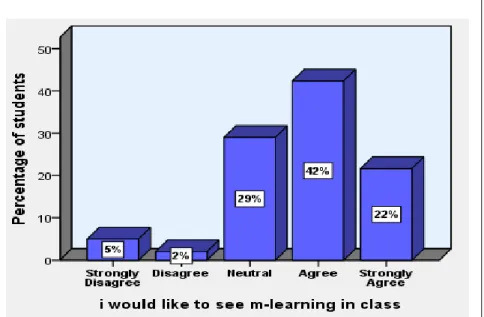
STUDENTS LIMITATIONS IN USE OF MOBILE DEVICES
The tablet computers in education projects aim to increase student access to educationally relevant content and enable communication with teachers and peers through online tools and resources for 24/7 learning” (Fritschi and Wolf, 2012). It could be the group of students who use their smartphones and not the tablet computer due to many reasons such as tablet computer not working or small smartphone size. 2.4% of the students did not know how to use mobile devices for school work, while 30.8% had no restriction to use their mobile devices for learning.
CHI-SQUARE TEST FOR ASSOCIATION
- C HI -S QUARE T ESTS : R ELATIONSHIP BETWEEN LEVEL OF STUDY AND MOBILE LEARNING AT UNIVEN
- C HI -S QUARE T ESTS : R ELATIONSHIP BETWEEN USE OF MOBILE DEVICES AND COMMUNICATION IMPROVEMENT
- C HI -S QUARE T ESTS : R ELATIONSHIP BETWEEN STUDENTS ’ ACCESS TO THE INTERNET AND THEIR PERCEPTIONS TOWARDS THE
Hₒ There is a relationship between students' access to the Internet and their perceptions about the use of mobile devices at UNIVEN. H1 There is no relationship between students' access to the Internet and their perceptions about the use of mobile devices at UNIVEN. As a result, the interviews confirmed that the students are progressing in using mobile devices for learning.

LECTURERS INTERVIEW ANALYSIS
- T ECHNOLOGY E XPERIENCE IN T EACHING
- M OBILE LEARNING A CTIVITIES
- T ABLET PC S IN C LASS
- C OMMUNICATING WITH M OBILE DEVICES
- I NCORPORATING MOBILE LEARNING IN C LASS
- A PPLICATIONS
- L ECTURERS ’ PERCEPTIONS OF MOBILE LEARNING IN EDUCATION
- T ABLET PC AS A LEARNING TOOL
It can be deduced from the above statements that some students no longer have the tablet PCs they received at the beginning of 2015. Furthermore, 20% of the respondents indicate that they do not like to use mobile devices in the classroom. All participants indicated that they were familiar with Microsoft Office, ie Word, Excel, PowerPoint and 50% of the respondents used the board.
STUDENTS INTERVIEW ANALYSIS
- M OBILE DEVICES ’ USE
- S TUDENTS ’ VIEWS ON COMMUNICATIONS WITH MOBILE DEVICES
- S TUDENTS ’ VIEWS ON A PPLICATIONS AND C ONVENIENCE OF MOBILE LEARNING
- S TUDY TIME MANAGEMENT
- I MPORTANCE OF MOBILE DEVICES
- P ERCEPTIONS OF MOBILE LEARNING IN EDUCATION
- T ABLET PC AS A LEANING TOOL
Agreement was reached with respondents that Wi-Fi is a necessity when it comes to using tablet PCs. Mobile devices such as tablet PCs and smartphones are one of the essential tools that can be used as a social networking platform in college. All respondents expressed their gratitude to the university for distributing tablet PCs to the students and the Wi-Fi on campus.
IT TECHNICIAN
- T ABLET PC ASSISTANCE
- N UMBER OF RETURNED TABLET PC S
- T ABLET PC S ’ P ROBLEMS
- F IXING T ABLET PC S ’ P ROBLEMS
All the respondents explained that the University should continue to distribute the tablet computers, as they help many students who cannot afford these devices, but they are necessary in the learning experience. The technician answered the question if they could solve all the tablet computer problems as IT technicians. Interaction with the respondent led to the understanding that the tablet computers have one year warranty.
SUMMARY
INTRODUCTION
DISCUSSION AND SUMMARY OF FINDINGS
The majority of teachers indicated that they would like their students to use mobile devices to enhance their study activities. Research question 3: How can mobile devices be used effectively for teaching and learning at UNIVEN. Therefore, recommendations were made on how best to use mobile devices to improve teaching and learning.
RECOMMENDATIONS
- R ECOMMENDATIONS TO THE M ANAGEMENT
- R ECOMMENDATIONS TO L ECTURERS
- R ECOMMENDATIONS TO S TUDENTS
- R ECOMMENDATIONS FOR FURTHER STUDIES
The survey found that some students do not use their mobile devices in class. It is recommended that teachers encourage their students to use their mobile devices for school work, such as recording lectures and taking photos of important information. It is recommended that students view their mobile devices beyond just means of communication, but primarily for learning.
LIMITATIONS OF THE STUDY
New studies may focus on the capabilities of newer technology and the investigation of how the use of a personal mobile device may affect learning. In collaboration with researchers from other fields, future researchers may also want to develop a program that can enable instructors to easily develop content-specific applications without software development knowledge. It would also be beneficial for future researchers to analyze how the use of specific mobile applications can be used in a classroom or used by students and faculty to promote informal learning.
CONCLUSION
Students and teachers should have been informed about the integration of mobile learning before using the devices. 17 Sept. 2015, from http://www.ambientinsight.com/resources/documents/Ambient-insight-2012-2017-worldwide-mobile-learning-market-executive-overview.pdf. An investigation of mobile learning readiness in higher education based on the theory of planned behaviour.
Retrieved August 24, 2015, from http://www.unesco.org/new/en/unesco/themes/icts/m4ed/mobile-learning-. Traditional learning is just as effective as mobile learning. I use social media to communicate with classmates about course-related issues using my tablet computer/smartphone.
PROOF READING LETTER
